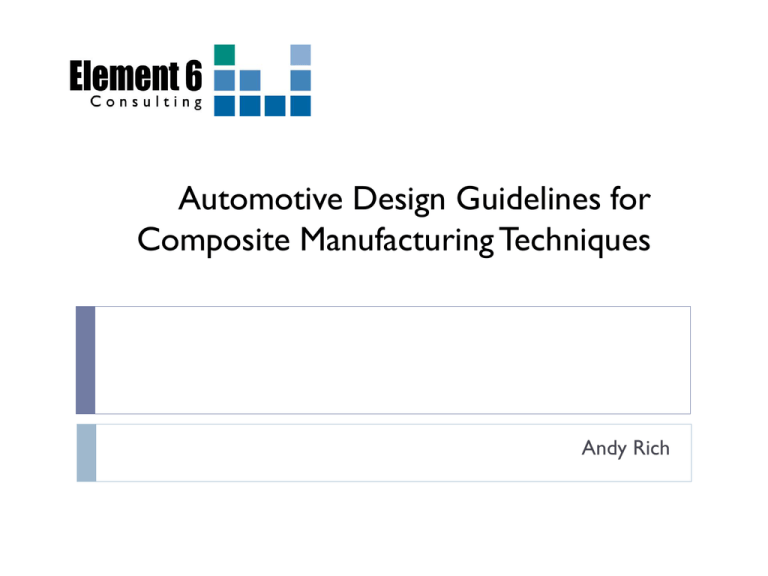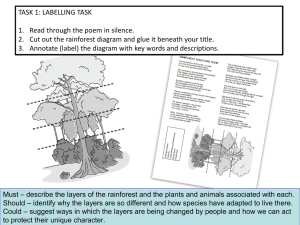composite design guideline presentation
advertisement

Automotive Design Guidelines for Composite Manufacturing Techniques Andy Rich Background 42 kg body on 200kg chassis 695 kg car 300 kg car 68 kg BIW 900 kg car Consulier 1990 890 kg complete car Glass Fibre Monocoque $60,000 Mosler MT900 900 kg car All- Carbon Fiber $180,000 Déjà vu all over again The Problem: How to get modern composites to work costeffectively as both primary structure and/or class-A surfaces. Do Not: Repeat the same mistakes that were done in the past. 10 Common Mistakes 1. 2. 3. 4. 5. Part thickness needs to be uniform. Component fiber layers must be quasi-isotropic. All fiber layers need to be stitched or woven. Every layer needs to be carbon. Ribs add stiffness, and carefully considered holes in the inner panels will reduce weight. 6. Assume that it is possible to make any shape. 7. Assume that there will always be a lot of scrap and nothing can be done about it. 8. Allow the number of subcomponent pre-forms to escalate out of control. Assembly of the final part wet-out/ cure stage should be as simple as possible. 9. Part integration can go too far; there is an inherent limit to the advantages of part integration. 10. Assume suppliers already make all possible fiber architectures, and you can already buy what you need out of existing catalogs. 10 Manufacturing Principles to Design in Engineered Composites1. 2. 3. 4. Use nest-able shapes – Whenever possible: Rectangles and trapezoids Consider the materials like they were Gold; - not to be wasted. Consider drape, and roll-width as design restrictions. Consider the pre-forming function to be as important, if not more important, than the final wet-out/ cure station. 5. Use fibers only where needed; use anisotropy as an advantage. 6. Not every layer needs to be carbon. 7. Final part thickness does not need to be uniform; it may incorporate overlaps. Consider single sided tooling. - at least in lower volumes. 8. Find a way to incorporate scrap into the finished part or final assembly. Plan early to utilize scrap. 9. Minimize the number of subcomponent pre-forms necessary. 10. Work with suppliers to provide pre-layered multi-material stacks. Most Important Manufacturing Principles: Multiple Processes for Multiple Applications 1. RTM should be used where it works the best, pre-pregs can be used where it makes the most sense, but braiding, and wet-compression, and thermoplastics will make sense in other applications. 2. Plan for disposable consumption of certain waste materials needed for the removal of air /voids. 3. Composite manufacturing systems in which a thermoset resin wets out a dry pre-form, will always benefit from having off-part edges. STOP TRYING TO MAKE NET SHAPE PARTS. #1 Part Thickness 1. Part thickness DOES NOT need to be uniform. This is especially true for structural components. In fact, as layers are built up, if one layer cannot be contiguous, it is far better to overlap the abutting pre-forms than to create a butt joint, which will inevitably be a weakness in the structure. #2. All Composites DO NOT need to be Isotropic, or “Act like” quasi-isotropic materials 0º 90º Laminates need to be balanced about the neutral axis, but that does not mean you need to add extra layers to create quasi-isotropic properties with respect to X and Y #3 & 4 – All layers do not need to be the same weave, or even the same fibers 8 layers Innegra 6/2 Innegra/carbon 4/4 Innegra/Carbon Innegra S 8 layers Carbon Carbon Fiber #3 & 4 – All layers do not need to be the same weave, or even the same fibers 8 layers Biomid 6/2 Biomid/carbon 4/4 Biomid/Carbon Biomid Cellulosic Fiber 8 layers Carbon Carbon Fiber Rule #5 – Stop Making Your Own Life Difficult 5a Ribs are not needed to add stiffness Ribs add stiffness to sheet metal, but just make composites more complicated and difficult to mold 5b - Holes in the inner panels will not save much weight and will significantly increase manufacturing complications which will introduce flaws. 5c - Minimum Radius of the panels edges will always tend to introduce flaws, if too tight. 6 - Choose shapes carefully Consider the drape of the fabric, and the width of the rolls, as well as the darts and overlaps that will be necessary. Think in terms of Nesting Shapes Maximize material usage 6 - Choose shapes carefully Think in Terms of Draping Fabrics 7 – Consider the Incorporation of Scrap and Re-Grind Many steps may be taken to minimize scrap by design. However, assume that you will have between 5% and 10% scrap rates depending on the processes used, and there are several uses for regrind - plan for it. 1. Tooling 2. Edge filling 3. Filleting 4. Bonding 5. Hiding read-through 6. Non-critical components 7. Impact Absorption 8 – Minimize the number of parts, but, . . . Part Integration can go too far 9 – Minimize the number of subcomponent pre-forms; A 3-minute wet-out cycle isn’t worth much if it takes 30 minutes to load the tool with 90 pre-forms 10 – Work with Suppliers to Minimize System Costs => Stop thinking in Euros/Kg. or $/lb. 1. Weavers 2. Multiple Fiber Suppliers 3. Resin manufacturers & pre-preg suppliers 4. Pre-Form Machinery Suppliers 5. Reclaiming and Recycling Suppliers 6. FEA Experts 7. Crash and Repair-ability Experts 8. Process Consultants We can provide impartial advice: 1. Pre-Form Machinery Suppliers 2. Reclaiming and Recycling Strategies 3. FEA Expertise 4. Crash and Repair-ability 5. Process Consultancy We offer extra help in: 1. Composite Vehicle Design 2. CAD Design for Composites 3. Drape and Formability of Fabrics 4. Pre-Form Machinery 5. Assembly Strategies and Part Count 6. Recycling Strategies 7. FEA Expertise 8. Crash and Repair-ability 9. Process Choices and Applicability 10.Achieving Class-A surface Finish Any Questions?







